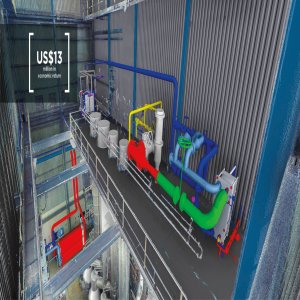Paving the Way for Small-Scale Cogeneration

STORY INLINE POST
Competitive costs and Mexico’s prioritization of clean energy places natural gas-fired technologies like cogeneration toe-to-toe with renewable energy technologies. Cogeneration can compete as a cost-effective large-scale technology but in smaller capacities, it is subject to a series of hurdles, says Jorge Gutiérrez, President of COGENERA.
The main problem, he says, is legislation, which favors large-scale cogeneration, such as PEMEX’s assets, with 200-400MW of installed capacity and 900-1,200t/h of steam. Gutiérrez says the current regulation is also favorable for intermediate cogeneration projects common in the paper, petrochemical, chemical and food industries, where cogeneration plants have capacities ranging from 20MW to 80MW. “As a result of regulations, costs can be prohibitive for small-scale cogeneration plants between 3MW and 10MW of installed capacity,” he says. “CENACE’s indicative system impact and facility studies for interconnection can cost up to US$20 million, equivalent to the installation of four small-scale cogeneration systems.”
Also working against these projects is that they operate in an isolated supply system. “While large-scale cogeneration plants are interconnected to CFE’s grid, small-scale systems only have an automatic transfer switch for when the steam turbines or motors fail,” says Gutiérrez.
Created as an exchange platform where public, private, financial and academic players meet to create coordinated action plans and initiatives to promote cogeneration, COGENERA engages in exchanges with the country’s energy authorities. It regularly drafts technical opinions on the Energy Reform’s content for the Ministry of Energy, CRE and CONUEE. “Cogeneration, since it does not use traditional fossil fuels, is considered a clean energy and is even eligible for CELs,” Gutiérrez explains. “Not all renewable power plants from the long-term electricity committed to going online in 2018 will do so, which could create a potential CELs supply gap with demand for 2018.” But he says as renewable energy power plants from subsequent auctions reach interconnection phase, this gap will be gradually resolved.
In Mexico, clean energy sources include PV, wind, geothermal, hydro, biogas, biomass, nuclear and efficient cogeneration, mirroring Germany and Spain’s scope that considers cogeneration equivalent to a certain point to renewable energy sources. CRE’s methodology considers cogeneration as a fossil fuel-free technology. As in some specific projects 48 percent of the total energy generated by cogeneration is fossil fuel-free, those MWh are eligible to be traded as CELs to help Mexico comply with its 5 percent clean energy consumption requirement. “As this is set to grow to 10 percent in 2021 and 15 percent in 2024, it is essential that the country looks to cleaner fuels,” says Gutiérrez.
Regulatory changes have also thrown up a financial hurdle. According to Gutiérrez, the most viable projects are those operating under a legacy contract, which considers the postage stamp tariff as a transmission cost under the previous Electricity Public Service Law. This means postage stamp rates are fixed and the projects are easier to finance. Under the new law, postage stamp costs are variable and their fluctuation depends on a wide array of factors, such as transmission distance, node saturation and grid status. This creates a higher transmission rate when selling energy surpluses either directly to market with spot-price uncertainty or to a third-party. This situation is exacerbated by the fact that energy trading contracts last no longer than five years versus a cogeneration plant’s 20 years of useful life.
Gutiérrez says that the lack of clarity in the market is making many financing entities reluctant to enter into the kind of long-term PPAs that would make cogeneration more viable. “No third party is willing or able to sign a 20-year PPA unless it is an energy intensive, large-scale consumer knowledgeable of how the market operates under new rules,” he says. While this variability generates unease for financial entities, Gutiérrez says COGENERA is in talks with development banks to convince them to view success cases from other countries as a reference. “The US PJM Interconnected System, California’s CAISO, or Texas’ ERCOT should be used as references to corroborate the profitability of a mature electricity spot market,” he says.
























